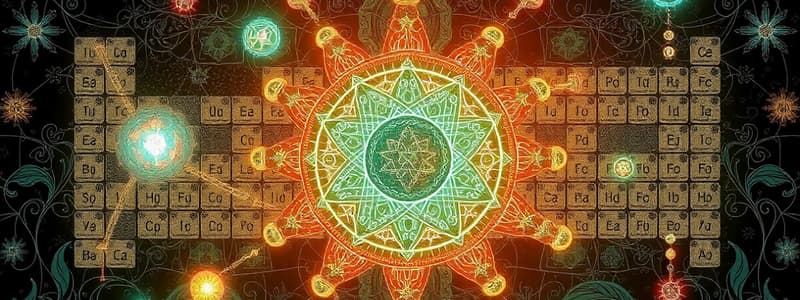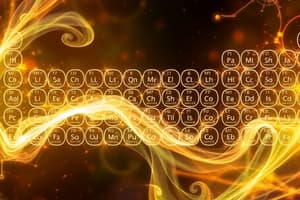Podcast
Questions and Answers
What is the relative mass of an electron in comparison to a proton?
What is the relative mass of an electron in comparison to a proton?
- Very small compared to a proton (correct)
- Slightly less than that of a proton
- Twice that of a proton
- Equal to that of a proton
How many maximum electrons can occupy the third energy shell of an atom?
How many maximum electrons can occupy the third energy shell of an atom?
- 8 (correct)
- 18
- 2
- 32
What is the mass number of Carbon-13?
What is the mass number of Carbon-13?
- 13 (correct)
- 6
- 14
- 12
Which of the following correctly describes the atomic number?
Which of the following correctly describes the atomic number?
What does the relative atomic mass equation represent?
What does the relative atomic mass equation represent?
Which group of elements includes lithium (Li)?
Which group of elements includes lithium (Li)?
What is the number of neutrons in Carbon-12?
What is the number of neutrons in Carbon-12?
Which separation method is used to isolate a soluble salt from a solution?
Which separation method is used to isolate a soluble salt from a solution?
Which chemical formula represents sodium chloride?
Which chemical formula represents sodium chloride?
What is the configuration of sodium (Na)?
What is the configuration of sodium (Na)?
Flashcards
Proton
Proton
A subatomic particle with a positive charge and a relative mass of 1.
Electron
Electron
A subatomic particle with a negative charge and a very small relative mass (often considered zero).
Atomic Number
Atomic Number
The number of protons in an atom's nucleus.
Mass Number
Mass Number
Signup and view all the flashcards
Isotope
Isotope
Signup and view all the flashcards
Relative Atomic Mass
Relative Atomic Mass
Signup and view all the flashcards
First Energy Shell
First Energy Shell
Signup and view all the flashcards
Filtration
Filtration
Signup and view all the flashcards
Evaporation
Evaporation
Signup and view all the flashcards
Crystallisation
Crystallisation
Signup and view all the flashcards
Study Notes
Atomic Structure
- Atoms are the smallest parts of an element
- Atoms have a nucleus, containing protons and neutrons
- Electrons orbit the nucleus
- Protons have a positive charge
- Neutrons have no charge
- Electrons have a negative charge
- Protons and neutrons have a similar mass
- Electrons are much smaller
- Mass number (A) is the sum of protons and neutrons
- Atomic number (Z) is the number of protons
- Isotopes are atoms of the same element with different numbers of neutrons
Elements and the Periodic Table
- Elements are arranged in the periodic table by atomic number
- Elements in the same group have similar properties
- Elements in the same period have increasing numbers of electron shells
- Metals are usually solid, shiny and good conductors of heat and electricity
- Non-metals are usually gases or brittle solids and poor conductors of heat and electricity
- The periodic table helps predict the properties of unknown elements
Bonding
- Atoms bond together to form compounds
- Ionic bonding involves the transfer of electrons between atoms creating ions
- Covalent bonding involves the sharing of electrons between atoms
- Metallic bonding involves delocalised electrons within a solid structure of metal atoms.
Chemical Reactions
- Chemical reactions involve the breaking and forming of bonds
- Chemical equations show the reactants and products of a reaction
- The state symbols (s, l, g, aq) indicate the state of the substances in a reaction (solid, liquid, gas, aqueous solution)
- Reactions can be represented by word equations or symbol equations
- Word equations use names of reactants and products
- Symbol equations use symbols of reactants and products and state symbols
Studying That Suits You
Use AI to generate personalized quizzes and flashcards to suit your learning preferences.




